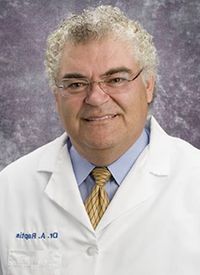Article
Frontline Combos Significantly Improve Outcomes in Multiple Myeloma
Author(s):
Anastasios Raptis, MD, highlights promising combinations under investigation in the frontline setting and remaining challenges in multiple myeloma.
Anastasios Raptis, MD

Anastasios Raptis, MD
The emergence of novel combinations in the frontline setting of multiple myeloma said led to significant survival gains, according to Anastasios Raptis, MD. Now, researchers are investigating if other promising approaches being explored in later lines of therapy, such as CAR T-cell therapy and bispecific T-cell engagers (BiTEs), could also be beneficial if moved upfront.
“With the incorporation of these novel agents, we have significantly improved the outcomes of our patients with myeloma; we have almost tripled the expected survival,” said Raptis. “With the incorporation of new approaches, such as immunotherapy and new drugs, we will further improve the survival of our patients over the next few years.”
Although the triplet of bortezomib (Velcade), lenalidomide (Revlimid), and dexamethasone serves as a frontline standard of care for patients with newly diagnosed disease, other promising combinations have recently emerged in the space.
Exciting data from the phase III MAIA (MMY3008) trial showed that frontline daratumumab (Darzalex) with lenalidomide, and dexamethasone (DRd) induced a 44% reduction in the risk of disease progression or death in transplant-ineligible patients with newly diagnosed disease compared with lenalidomide/dexamethasone alone (HR, 0.56; 95% CI, 0.43-0.73; P <.0001).1,2 These data led to the FDA’s decision to approve the triplet in June 2019 for use in this population.
Another promising combination poised to enter the paradigm is frontline carfilzomib (Kyprolis), lenalidomide, and dexamethasone (KRd), as it has shown superior objective response rates, irrespective of risk status, and attainment of minimal residual disease negativity when compared with cyclophosphamide/dexamethasone in patients with newly diagnosed disease. Currently, once-weekly carfilzomib is FDA approved for use in combination with dexamethasone in the relapsed/refractory setting.
In an interview during the 2019 OncLive® State of the Science Summit™ on Hematologic Malignancies, Raptis, a clinical assistant professor of medicine at the University of Pittsburgh School of Medicine, Hillman Cancer Center, highlighted promising combinations under investigation in the frontline setting and remaining challenges in the space.
OncLive®: Could you provide a brief overview of some of the key updates in the frontline treatment of multiple myeloma?
Raptis: What has become the standard of care in the United States for patients with newly diagnosed multiple myeloma—both transplant eligible and transplant ineligible—is a combination of bortezomib, lenalidomide, and dexamethasone.
There are also new drugs, such as daratumumab, in the newly diagnosed patients with multiple myeloma, as well as the importance of achieving molecular remission status and the impact of that status on the expected survival of our patients. We will also discuss the combination of KRd, which is very effective for newly diagnosed patients with myeloma, particularly for those who have high-risk disease.
Could you speak to data seen with DRd in transplant-ineligible patients? What is the hope for this triplet regimen?
There have been very promising results seen with the DRd combination. Particularly what is very important and very attractive is the hazard ratio; that has shown a 44% decrease in the risk of progression or death. Also, [the combination] has shown a very high rate of molecular remission, so we hope that the introduction of this novel [regimen] in the upfront setting will further improve the outcomes of our patients with myeloma.
What a some of the key challenges that still need to be overcome in this field?
A key element is to apply the appropriate strategy for our patients. Since we have so many options now, it is very important [that we] utilize the newly incorporated drugs in the appropriate fashion and in a very strategic [way] in order to improve the outcomes of our patients. [Doing this could ultimately] lead to better survival.
A [remaining] challenge is that the disease may come back; [patients] can relapse. Although we have improved survival, we have not cured the disease yet. We hope with the deepening of the response and improvement in the quality of response that we achieve with new agents, we might be able to start talking about cure in the next few years.
We’ve seen a lot of work with CAR T-cell therapy in later lines of therapy. Do you see this therapeutic approach being moved to the frontline space?
It is a possibility, yes. However, we need more data [with this approach] in the relapsed setting—safety as well as outcome data—before we start talking about moving the CAR T-cell therapies into the upfront setting.
Do you have similar thoughts about the BiTE antibodies?
Exactly; it’s the same concept with the BiTE antibodies. We have to prove the safety and efficacy [of this approach] in the relapsed setting before we start moving these approaches into newly diagnosed patients.
What is it about carfilzomib that could give it an advantage over other agents?
With carfilzomib, we do have data in the relapsed setting that it is a very effective drug in patients with multiple myeloma. But what is are is the long-term complete remission rates and the long-term molecular remission rates [seen with the agent], particularly in patients who have high-risk cytogenetics; that is a very attractive field but it needs further exploration.
References
- Facon T, Kumar SK, Plesner T, et al. Phase 3 randomized study of daratumumab plus lenalidomide and dexamethasone (D-Rd) versus lenalidomide and dexamethasone (Rd) in patients with newly diagnosed multiple myeloma (NDMM) ineligible for transplant (MAIA). Blood. 2018;132(suppl 1):LBA-2. doi: 10.1182/blood-2018-120737.
- Facon T, Kumar S, Plesner T, et al. Daratumumab plus lenalidomide and dexamethasone for untreated myeloma. N Engl J Med. 2019;380(22):2104-2115. doi: 10.1056/NEJMoa1817249.









